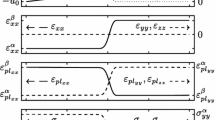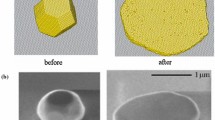Abstract
We introduce a small strain elasto-plastic multiphase-field model according to the mechanical jump conditions. A rate-independent \(J_2\)-plasticity model with linear isotropic hardening and without kinematic hardening is applied exemplary. Generally, any physically nonlinear mechanical model is compatible with the subsequently presented procedure. In contrast to models with interpolated material parameters, the proposed model is able to apply different nonlinear mechanical constitutive equations for each phase separately. The Hadamard compatibility condition and the static force balance are employed as homogenization approaches to calculate the phase-inherent stresses and strains. Several verification cases are discussed. The applicability of the proposed model is demonstrated by simulations of the martensitic transformation and quantitative parameters.





Similar content being viewed by others
References
Boettinger WJ, Warren JA, Beckermann C, Karma A (2002) Phase field simulation of solidification. Annu Rev Mater Res 32:63–94
Chen L-Q (2002) Phase-field models for microstructure evolution. Annu Rev Mater Res 32:113–140
Moelans N, Blanpain B, Wollants P (2008) An introduction to phase-field modeling of microstructure evolution. Calphad Comput Coupl Phase Diag Thermochem 32(2):268–294
Steinbach I (2013) Phase-field model for microstructure evolution at the mesoscopic scale. Annu Rev Mater Res 43:89–107
Mamivand M, Zaeem MA, El Kadiri H (2013) A review on phase field modeling of martensitic phase transformation. Comput Mater Sci 77:304–311
Ambati M, Gerasimov T, De Lorenzis L (2015) Phase-field modeling of ductile fracture. Comput Mech 55:1017–1040
Schneider D, Schoof E, Huang Y, Selzer M, Nestler B (2016) Phase-field modeling of crack propagation in multiphase systems. Comput Methods Appl Mech Eng 312:186–195
Chen L-Q, Khachaturyan AG (1991) Computer simulation of structural transformations during precipitation of an ordered intermetallic phase. Acta Metall Mater 39:2533–2551
Uehara T, Tsujino T, Ohno N (2007) Elasto-plastic simulation of stress evolution during grain growth using a phase field model. J Cryst Growth 300:530–537
Schmitt R, Müller R, Skorupski R, Smaga M, Eifler D (2013) A phase field approach for martensitic transformations in elastoplastic materials. PAMM 13:213–214
Schneider D, Schmid S, Selzer M, Böhlke T, Nestler B (2015) Small strain elasto-plastic multiphase-field model. Comput Mech 55:27–35
Ubachs RLJM, Schreurs PJG, Geers MGD (2004) A nonlocal diffuse interface model for microstructure evolution of tin–lead solder. J Mech Phys Solids 52:1763–1792
Yamanaka A, Takaki T, Tomita Y (2008) Elastoplastic phase-field simulation of self- and plastic accommodations in cubic—tetragonal martensitic transformation. Mater Sci Eng A 491:378–384
Gaubert A, Le Bouar Y, Finel A (2010) Coupling phase field and viscoplasticity to study rafting in Ni-based superalloys. Philos Mag 90:375–404
De Rancourt V, Ammar K, Appolaire B, Forest S (2016) Homogenization of viscoplastic constitutive laws within a phase field approach. J Mech Phys Solids 88:291–319
Yamanaka A, Takaki T (2009) Crystal plasticity phase-field simulation of deformation behavior and microstructure. In: Proc. X int. conf. on comput. plast. (vol 462, pp 1–4)
Schmitt R, Kuhn C, Bhattacharya K (2014) Crystal plasticity and martensitic transformations—a phase field approach. Sci J Fundam Appl Eng Mech 34:23–38
Schmitt R, Kuhn C, Mueller R (2015) On a phase field approach for martensitic transformations in a crystal plastic material at a loaded surface. Contin Mech Thermodyn 29:957–968
Leonard F, Desai R (1998) Spinodal decomposition and dislocation lines in thin films and bulk materials. Phys Rev B 58:8277–8288
Hu SY, Chen LQ (2001) A phase-field model for evolving microstructures with strong elastic inhomogeneity. Acta Mater 49:1879–1890
Wang YU, Jin YM, Cuitino AM, Khachaturyan AG (2001) Nanoscale phase field microelasticity theory of dislocations: model and 3D simulations. Acta Mater 49:1847–1857
Rodney D, Le Bouar Y, Finel A (2003) Phase field methods and dislocations. Acta Mater 51:17–30
Zhou N, Shen C, Mills MJ, Wang Y (2007) Phase field modeling of channel dislocation activity and gamma prime rafting in single crystal Ni–Al. Acta Mater 55:5369–5381
Ammar K, Appolaire B, Cailletaud G, Forest S (2009) Combining phase field approach and homogenization methods for modelling phase transformation in elastoplastic media. Eur J Comput Mech 18:485–523
Nestler B, Garcke H, Stinner B (2005) Multicomponent alloy solidification: phase-field modeling and simulations. Phys Rev E 71:1–6
Schneider D, Schwab F, Schoof E, Reiter A, Herrmann C, Selzer M, Böhlke T, Nestler B (2017) On the stress calculation within phase-field approaches: a model for finite deformations. Comput Mech 60(2):203–217
Beckermann C, Diepers H-J, Steinbach I, Karma A, Tong X (1999) Modeling melt convection in phase-field simulations of solidification. J Comput Phys 154:468–496
Moelans N, Blanpain B, Wollants P (2008) Quantitative analysis of grain boundary properties in a generalized phase field model for grain growth in anisotropic systems. Phys Rev B 78:024113
Steinbach I, Pezzolla F (1999) A generalized field method for multiphase transformations using interface fields. Phys D 134:385–393
Silhavy M (1997) The mechanics and thermodynamics of continuous media. Springer, Berlin
Moelans N (2011) A quantitative and thermodynamically consistent phase-field interpolation function for multi-phase systems. Acta Mater 59:1077–1086
Schneider D, Tschukin O, Choudhury A, Selzer M, Böhlke T, Nestler B (2015) Phase-field elasticity model based on mechanical jump conditions. Comput Mech 55:887–901
Ammar K, Appolaire B, Forest S, Cottura M, Bouar YL, Finel A (2014) Modelling inheritance of plastic deformation during migration of phase boundaries using a phase field method. Meccanica 49:2699–2717
Ostwald R, Bartel T, Menzel A (2011) A one-dimensional computational model for the interaction of phase-transformations and plasticity. Int J Struct Changes Sol 3:63–82
Simo J C, Hughes T J R (1998) Computational inelasticity. Springer, New York
Schneider D (2017) Phasenfeldmodellierung mechanisch getriebener Grenzflaechenbewegungen in mehrphasigen Systemen, 2017
Yeddu HK, Lookman T, Saxena A (2013) Strain-induced martensitic transformation in stainless steels: a three-dimensional phase-field study. Acta Mater 61:6972–6982
Heo T, Chen L (2014) Phase-field modeling of displacive phase transformations in elastically anisotropic and inhomogeneous polycrystals. Acta Mater 76:68–81
Xu G, Wang C, Beltrán J I, LLorca J, Cui Y (2016) Landau modeling of dynamical nucleation of martensite at grain boundaries under local stress. Comput Mater Sci 118:103–111
Khachaturyan A G (1983) Theory of structural transformations in solids. Wiley, New York
Yamanaka A, Takaki T, Tomita Y (2010) Elastoplastic phase-field simulation of martensitic transformation with plastic deformation in polycrystal. Int J Mech Sci 52:245–250
Schneider D, Schoof E, Tschukin O, Reiter A, Herrmann C, Schwab F, Selzer M, Nestler B (2017) Small strain multiphase-field model accounting for configurational forces and mechanical jump conditions. Comput Mech 1–19.
Schoof E, Schneider D, Streichhan N, Mittnacht T, Selzer M, Nestler B (2018) Multiphase-field modeling of martensitic phase transformation in a dual-phase microstructure. Int J Solids Struct 134:181–194
Guo XH, Shi S-Q, Ma XQ (2005) Elastoplastic phase field model for microstructure evolution. Appl Phys Lett 87:221910
Yeddu HK, Borgenstam A, Hedström P, Agren J (2012) A phase-field study of the physical concepts of martensitic transformations in steels. Mater Sci Eng A 538:173–181
Acknowledgements
We thank the Daimler AG for funding our investigations. Additionally the authors thank the German Research Foundation for funding through the graduate schools GRK 1483 and GRK 2078. Furthermore, support by the Helmholtz program RE is acknowledged. The authors gratefully acknowledge the editorial support by Leon Geisen.
Author information
Authors and Affiliations
Corresponding author
Rights and permissions
About this article
Cite this article
Herrmann, C., Schoof, E., Schneider, D. et al. Multiphase-field model of small strain elasto-plasticity according to the mechanical jump conditions. Comput Mech 62, 1399–1412 (2018). https://doi.org/10.1007/s00466-018-1570-0
Received:
Accepted:
Published:
Issue Date:
DOI: https://doi.org/10.1007/s00466-018-1570-0




